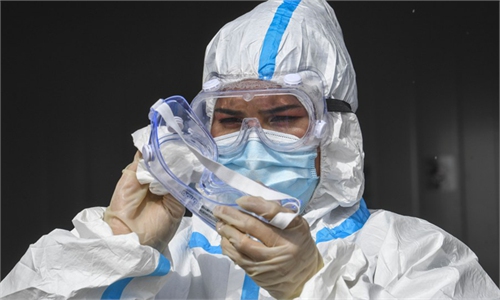
An epidemic prevention staff member processes a protective goggle at Karasu port of northwest China's Xinjiang Uygur Autonomous Region, Oct. 16, 2020.(Photo: Xinhua)
After being stranded for hours on the highways in Ili Kazakh Autonomous Prefecture, Northwest China's Xinjiang Uygur Autonomous Region, which saw a COVID-19 resurgence early this week, some tourists left in an orderly way starting on Thursday afternoon, those involved told the Global Times.
At least 300 tourists and their vehicles stayed for "more than 30 hours" at highway toll stations in Ili, before they were asked to return to nearby towns on Wednesday for temporary stays to avoid possible virus transmission, the Global Times learned.
A flight departed from Yining Airport in Ili for Beijing at about 5 pm on Thursday, China Central Television reported. Minutes earlier, a female passenger said that she had boarded the plane.
"We [passengers] congratulated each other," she told the Global Times.
Other self-driving tourists in Ili said that they were also on their way back home, after the local main expressways reopened for departing vehicles late in the afternoon on Thursday after more than two days of being shut down.
The Ili authority said on Thursday that it will coordinate more departing flights and trains for tourists, and arrange hotels for the remaining ones.
Those who want to leave the prefecture should present negative nucleic acid test results taken within the previous 48 hours, and sign a statement that they hadn't been to the COVID-19 hit areas, according to the latest notice that the stranded tourists received.
Xinjiang had found one confirmed case and four asymptomatic ones as of Thursday afternoon, since it reported two silent carriers in its border city Khorgas in Ili on Sunday.
The two cases were infected with the Delta variant, the Ili government said during a press conference on Thursday night.
Gene sequencing showed the viruses the two patients were infected with were "100-percent homologous," but had little relation to recent domestic or imported cases, the government said.
The unexpected COVID-19 resurgence in Xinjiang during the National Day holidays, China's traditional travel peak, stranded and upset many tourists in the region, one of the most popular travel destinations.
Earlier, Ili required these tourists to temporarily remain, the Beijing Youth Daily reported, quoted local epidemic control authorities as saying on Sunday.
In Ili, many self-driving tourists, who hoped to leave earlier this week before the highways reopened, flooded two local expressway toll stations on Tuesday and Thursday.
A tourist surnamed Li, on a self-driving trip in Xinjiang with his three friends, said they stayed at the Huiyuan East toll gate on the Qingshuihe-Yining Expressway for 38 hours, until being persuaded to return on Wednesday afternoon.
Almost all the involved tourists were later arranged to stay in Xinyuan county, which is more than 200 kilometers away, as of Thursday evening.
"We still can't go," Li told the Global Times. "All the flight tickets leaving Xinjiang are sold out."
Many tourists said the rainy weather in Ili, with the lowest temperature below zero, meant they were very hungry and cold after staying for hours at the toll gates.
"It was so cold, that I was awake all night in my car," a tourist named An (pseudonym) told the Global Times.
Ili officials sent them steamed buns and milk during their stay there, An added.
The epidemic situation in Ili deserves high attention and strict control in the early stages, noted Wang Guangfa, a respiratory expert at the Peking University First Hospital.
The variant being spread in this round of COVID-19 outbreaks is still the more contagious Delta, and the origins of this round of COVID-19 outbreaks haven't been traced, Wang explained.
Ili has populous border cities like Khorgas, and is a popular destination for tourists from across the country, Wang said. The origins are probably either local residents, especially those engaged in border trading and logistics, or incoming visitors, he said.
"The current top priority is to find the origins," Wang told the Global Times.
The National Health Commission under the State Council, the cabinet, sent a working group to instruct the epidemic prevention work in Ili on Monday.
Prior to that, there had been neither confirmed nor asymptomatic cases in the whole of Xinjiang for 22 days.


